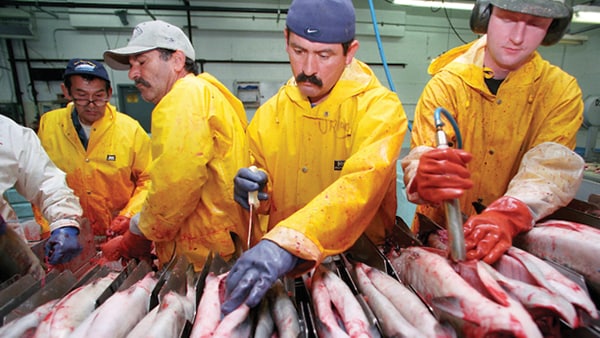Key points
The seafood processing industry in the United States consists of a global workforce, with many workers having limited or no English-language skills. A study of safety and health programs in Alaska’s seafood processing industry identified language barriers with employees as the most common challenge reported by safety and health managers.

What is the health and safety problem?
In the United States, English literacy is an important aspect of public health.1 Across industries, different languages and low literacy are barriers to ensuring workplace safety and health.2
The Occupational Safety and Health Administration provides guidelines for how employers must communicate with their employees. They must:
- Instruct employees using both a language and vocabulary that the employees can understand. If an employee does not speak or comprehend English, the employer must provide instruction in a language the employee can understand.
- Provide training at the reading/vocabulary level of the employee. If the employee has limited vocabulary, the training must account for that limitation.
- Do not rely on written training only. If employees are not literate, telling them to read training materials will not satisfy the employer's training obligation. Consider other training methods.
What is the extent of the problem?
Around the United States, the seafood processing industry consists of a global workforce, with many workers having limited or no English-language skills.34
In a study of safety and health programs in Alaska's seafood processing industry, language barriers with their employees were the most common challenge reported by safety and health managers.5 Other than English, the most commonly spoken languages among workers were Spanish, Tagalog, Samoan, French, Somali, and Arabic, as well as various Oceanic, African, Eastern European, and Alaska Native languages. Managers described a variety of methods to overcome these barriers, such as translating materials and incorporating visuals and hands-on activities into their training.5
What are recommendations for addressing language barriers?
Appropriately use translators and interpreters67
- Hire professional interpreters and translators
- Bilingual workers acting as interpreters may have limited abilities to interpret and communicate complex issues effectively, therefore:
- Invest in education and ongoing support/coaching of trusted individuals ("worker-trainers") who in turn provide training to their peers
- Build bilingual infrastructure by finding or developing bilingual managers, potentially from countries where employers recruit workers
- Use native-speaking translators with in-depth knowledge of the topic
It is important to consider that direct translation of written materials from English to other languages does not necessarily guarantee literacy, language, or cultural appropriateness.8
Develop effective trainings and materials79
- Keep training materials at a limited literacy level (e.g., 6th grade reading level)
- Use clear and realistic illustrations, graphics, photographs, and video to convey messages
- Use higher learner-engagement methods to improve the effectiveness of the training (e.g., behavioral modeling, simulation, and hands-on training)
- Include basic education on occupational safety and health laws and workers' rights
- Conduct pilot testing of trainings with workers
Visit the CDC's Health Literacy site to find information, tools, and links on health literacy research, practice, and evaluation for public health topics and situations to help address language and literacy barriers.
- CDC. (2016). What is Health Literacy? Retrieved from: https://www.cdc.gov/healthliteracy/learn/index.html
- Gany F, Dobslaw R, Ramirez J, et al. (2011). Mexican urban occupational health in the U.S.: A population at risk. Journal of Community Health, 36(2):175-179.
- Garcia GM, De Castro B. Working conditions, occupational injuries, and health among Filipino fish processing workers in Dutch Harbor, Alaska. Workplace Health Saf. 2017;65(5):219–226. https://doi.org/10.1177/2165079916665396.
- American University Washington College of Law, Centro de los Derechos del Migrante & Georgetown University Law Center. (2020.) Breaking the shell: How Maryland's migrant crab pickers continue to be 'picked apart.' https://cdmigrante.org/wp-content/uploads/2020/09/Breaking-The-Shell.pdf
- Syron LN, Bovbjerg VE, Mendez-Luck CA, Kincl L [2019]. Safety and health programs in Alaska's seafood processing industry: Interviews with safety and health managers. J Agromedicine, 24(4), 449-461. https://doi.org/10.1080/1059924X.2019.1639578.
- O’Connor T, Flynn M, Weinstock D, et al. Occupational safety and health education and training for underserved populations. New Solutions: A Journal of Environmental and Occupational Health Policy. 2014; 24(1), 83-106.
- Brunette MJ. Development of educational and training materials on safety and health: Targeting Hispanic workers in the construction industry. Family & Community Health. 2005; 28(3), 253-266.
- Arcury TA, Estrada JM, Quandt SA. Overcoming language and literacy barriers in safety and health training of agricultural workers. Journal of Agromedicine. 2010; 15(3), 236-248.
- Burke MJ, Sarpy SA, Smith-Crowe K, et al. Relative effectiveness of worker safety and health training methods. American Journal Public Health. 2006; 96(2), 315-324.
